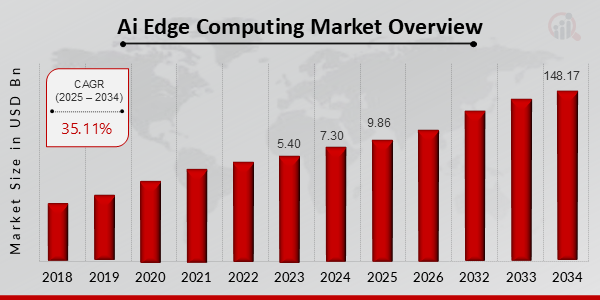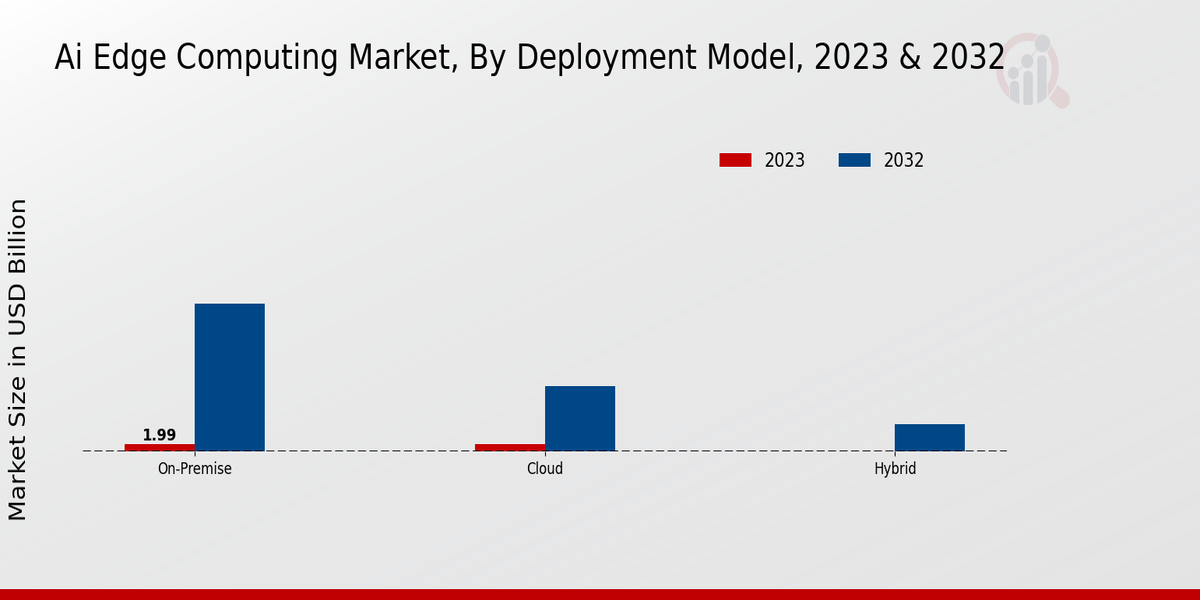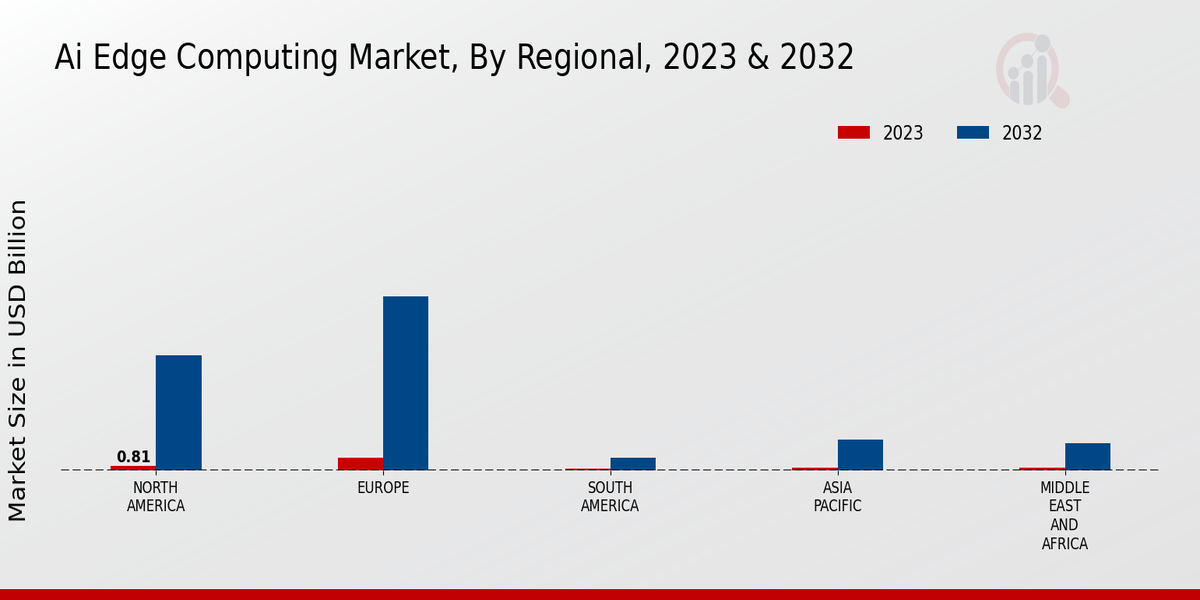Ai Edge Computing Market Overview
Ai Edge Computing Market is projected to grow from USD 9.86 Billion in 2025 to USD 148.17 Billion by 2034, exhibiting a compound annual growth rate (CAGR) of 35.11% during the forecast period (2025 - 2034). Additionally, the market size for Ai Edge Computing Market was valued at USD 7.30 billion in 2024.
Key Ai Edge Computing Market Trends Highlighted
The advent of AI edge computing is revolutionizing the way data is processed and analyzed, enabling real-time decision-making and improved operational efficiency. The convergence of AI with edge computing enables the deployment of AI capabilities closer to data sources, reducing latency and enhancing the accuracy of data analysis.Key market drivers include the increasing adoption of IoT devices, the proliferation of data-intensive applications, and the demand for faster insights and responsiveness. Opportunities lie in the exploration of new AI applications, such as predictive maintenance, remote diagnostics, and personalized user experiences.
Recent trends in the market include the adoption of cloud-native edge computing platforms, the integration of AI and machine learning algorithms, and the emergence of 5G networks, which enhance connectivity and enable the deployment of more sophisticated AI models. These trends are expected to further accelerate the growth of the AI edge computing market in the coming years.
Figure 1: Ai Edge Computing Market, 2025 - 2034

Source: Primary Research, Secondary Research, MRFR Database and Analyst Review
Ai Edge Computing Market Drivers
Rising Demand for Real-Time Data Analytics
The primary driver for the Ai Edge Computing Market Industry is the increasing need for real-time data analytics. With businesses seeking to make better decisions and respond to the markets quickly, they need access to real-time data. Ai augmented analytics at the edge of the cloud allow for processing and analysis of data closer to its source. It also helps enable faster processing and analysis, with vital applications for real-time analytics, fraud detection, predictive maintenance, and system optimization. With Ai deployed at the edge, businesses can access real-time insights and act on market events with the necessary agility.
Growth of IoT and Connected Devices
The proliferation of IoT devices and increasing connectivity of devices. With the surge in IoT devices, more connections are generated by these devices. As such, data is generated at an exponential rate. In order to provide value, data needs to be processed and analyzed. With the help of edge computing, data can be processed at the edge of the network, which is at the proximal of the data source. By deploying Ai at the edge, businesses can derive useful insights from their IoT data. These aforesaid insights can be utilized to optimize business operations and decision-making.
Advancements in Artificial Intelligence
The rapid development of Artificial intelligence is one of the reasons why the Ai Edge Computing Market Industry is expanding. Currently, Ai algorithms are more advanced and, accordingly, require more computing power to run. This is when edge computing can be of help. Its main idea is deploying Ai algorithm at the edge of the network so that it is as close to the data as possible. The main advantage of such an approach is reduced latency, which is beneficial for the better performance of Ai applications. In conclusion, Ai at the Edge enables businesses to work faster, be more innovative, make better decisions, and gain more profit.
Ai Edge Computing Market Segment Insights
Ai Edge Computing Market Deployment Model Insights
The deployment segment of the Ai Edge Computing Market is divided into on-premise, cloud, and hybrid. Among these, the on-premise segment is one of the most prominent, having accumulated over 60% of the global revenue in 2023. The rapid and steady growth of this segment is primarily associated with concerns of data security and compliance, as well as a demand for processing data in real-time across multiple industries. However, the fastest-growing segment is the cloud one, which is expected to continue its expansion throughout the forecast period at 38% CAGR.
This development can be ascribed to the growing adoption of cloud-based services, an increasing number of edge computing platforms, as well as continuously intensified demand for remotely locating and processing data. The third important segment is the hybrid one, which demonstrates a combination of the two advantages of the on-premise and cloud deployment and can build traction along with the continued expansion of the market. Several key factors and parameters influence and are influenced by the deployment segment. Those include general data sensitivity and latency, infrastructure costs, as well as compliance-related issues.
As a result, companies and organizations that require the introduction and implementation of AI edge computing solutions are advised to choose the most adequate deployment model that caters to their specific requirements. Proper consideration should be given to the strengths and weaknesses of different deployment options, and their potential impact on key parameters, such as the overall performance, security, and cost-effectiveness of an AI edge computing solution. The on-premise segment is projected to reach over USD 20 billion during the forecast period, while the cloud option could surpass USD 35 billion over that time frame. The hybrid one is expected to become one of the most important segments of the market due to its flexibility.
Figure 2: Ai Edge Computing Market, By Condition, 2023 & 2032

Source: Primary Research, Secondary Research, MRFR Database and Analyst Review
Ai Edge Computing Market Application Insights
The Ai Edge Computing Market segmentation by Application is categorized into Predictive Maintenance, Process Optimization, Quality Control, Safety and Security, and Others. Predictive Maintenance segment held the largest market share in 2023. The rising adoption of AI-powered predictive maintenance solutions to optimize asset performance and reduce downtime drives the growth of this segment. Over the forecast period, the Process Optimization segment is anticipated to grow at a significant CAGR owing to the increasing demand for AI-based solutions to enhance operational efficiency and reduce costs.
The Quality Control segment is also expected to witness substantial growth due to the growing need for AI-based quality inspection systems to ensure product quality. The Safety and Security segment is projected to grow at a moderate pace, driven by the rising concerns regarding safety and security in various industries. The Others segment includes applications such as remote monitoring, data analytics, and decision support, which are expected to contribute to the overall market growth.
Ai Edge Computing Market End User Industry Insights
The end-user industry segment of the Ai Edge Computing Market is diverse, with various industries adopting this technology to enhance their operations. Manufacturing leads the segment, leveraging Ai Edge Computing for predictive maintenance, quality control, and automated production lines, contributing significantly to the Ai Edge Computing Market revenue. Healthcare follows closely, utilizing Ai Edge Computing for real-time patient monitoring, medical imaging analysis, and remote patient care, driving market growth. Retail employs Ai Edge Computing for personalized customer experiences, optimizing inventory management, and enhancing supply chain efficiency, boosting market statistics.
Transportation and logistics leverage Ai Edge Computing for fleet management, predictive maintenance, and route optimization, contributing to industry growth. Energy and utilities utilize Ai Edge Computing for grid optimization, renewable energy integration, and predictive maintenance, expanding the Ai Edge Computing Market data. These industries' increasing adoption of Ai Edge Computing is expected to drive market segmentation and contribute to the overall market growth in the coming years.
Ai Edge Computing Market Regional Insights
The Ai Edge Computing Market is segmented into North America, Europe, APAC, South America, and MEA. North America is expected to hold the largest market share in 2023, owing to the presence of major technology companies and early adoption of AI technologies. Europe is expected to be the second-largest market, followed by APAC. APAC is expected to witness the highest growth rate during the forecast period due to the increasing adoption of AI technologies in emerging economies such as China and India. South America and MEA are expected to have a relatively smaller market share, but they are expected to grow at a significant rate during the forecast period.
Figure 3: Ai Edge Computing Market, By Regional, 2023 & 2032

Source: Primary Research, Secondary Research, MRFR Database and Analyst Review
Ai Edge Computing Market Key Players And Competitive Insights
Major players in Ai Edge Computing Market industry are constantly engaging in strategic collaborations, acquisitions, and partnerships to expand their market presence and gain a competitive edge. Leading Ai Edge Computing Market players are investing heavily in research and development to introduce innovative solutions and enhance their product portfolio. The Ai Edge Computing Market development is driven by factors such as the increasing adoption of artificial intelligence (AI) and machine learning (ML) technologies, the proliferation of connected devices, and the growing demand for real-time data processing. The Ai Edge Computing Market Competitive Landscape is expected to remain highly competitive, with established players and new entrants vying for market share.
The Ai Edge Computing Market industry is characterized by the presence of several leading players, including NVIDIA, Intel, Microsoft, Amazon Web Services (AWS), and Google Cloud Platform (GCP). These companies offer a comprehensive range of Ai Edge Computing Market solutions, including hardware, software, and cloud services. NVIDIA is a prominent player in the market, known for its high-performance graphics processing units (GPUs) and its AI software platform, NVIDIA CUDA. Intel, another major player, offers a wide range of Ai Edge Computing Market solutions, including processors, FPGAs, and software tools. Microsoft provides a cloud-based Ai Edge Computing Market platform, Azure IoT Edge, while AWS and GCP offer similar services with AWS IoT Greengrass and Google Cloud IoT Edge, respectively.A leading company in the Ai Edge Computing Market is NVIDIA. The company has a strong presence in the market owing to its innovative products and strategic partnerships. NVIDIA's GPUs are widely used in various AI and ML applications, including image recognition, natural language processing, and autonomous driving. The company's CUDA platform provides a comprehensive software environment for developing and deploying AI applications. NVIDIA has also partnered with several leading technology companies, including Microsoft, Amazon, and Google, to integrate its products with their cloud platforms. The company's continued investment in R&D and its focus on developing innovative solutions are expected to help it maintain its leadership position in the Ai Edge Computing Market.
Key Companies in the Ai Edge Computing Market Include
- Texas Instruments Incorporated
- Qualcomm Technologies, Inc.
- Amazon Web Services, Inc.
- Renesas Electronics Corporation
- Huawei Technologies Co., Ltd.
- Samsung Electronics Co., Ltd.
- Advanced Micro Devices, Inc.
- Cypress Semiconductor Corporation
Ai Edge Computing Market Industry Developments
The Ai Edge Computing Market is projected to experience substantial growth in the coming years. In 2023, the market was valued at around USD 4.0 billion and is expected to reach over USD 60.0 billion by 2032, exhibiting a CAGR of approximately 35.11%. The increasing adoption of AI technologies, the growing demand for real-time data processing, and the need for improved operational efficiency are key factors driving the market growth.Recent developments in the market include the launch of new AI-powered edge computing platforms, partnerships between major technology companies, and the emergence of innovative applications in various industries. For instance, in 2023, Microsoft announced the release of its Azure Percept platform, designed to simplify the development and deployment of AI solutions at the edge. Additionally, companies like NVIDIA and Qualcomm are collaborating to provide comprehensive AI edge computing solutions. These advancements are expected to further accelerate the adoption of AI edge computing across industries such as manufacturing, healthcare, and retail.
Ai Edge Computing Market Segmentation Insights
-
Ai Edge Computing Market Deployment Model Outlook
-
Ai Edge Computing Market Application Outlook
-
Ai Edge Computing Market End User Industry Outlook
- Transportation and Logistics
-
Ai Edge Computing Market Regional Outlook
|
Report Attribute/Metric
|
Details
|
|
Market Size 2024
|
7.30 (USD Billion)
|
|
Market Size 2025
|
9.86 (USD Billion)
|
|
Market Size 2034
|
148.17 (USD Billion)
|
|
Compound Annual Growth Rate (CAGR)
|
35.11% (2025 - 2034)
|
|
Report Coverage
|
Revenue Forecast, Competitive Landscape, Growth Factors, and Trends
|
|
Base Year
|
2024
|
|
Market Forecast Period
|
2025 - 2034
|
|
Historical Data
|
2019 - 2023
|
|
Market Forecast Units
|
USD Billion
|
| Key Companies Profiled |
Texas Instruments Incorporated, IBM Corporation, Qualcomm Technologies, Inc., Amazon Web Services, Inc., Renesas Electronics Corporation, Intel Corporation, Huawei Technologies Co., Ltd., Microsoft Corporation, Samsung Electronics Co., Ltd., Advanced Micro Devices, Inc., Cypress Semiconductor Corporation, Google LLC, NVIDIA Corporation, Xilinx, Inc., AMD, Inc. |
| Segments Covered |
Deployment Model, Application, End User Industry, Regional |
| Key Market Opportunities |
Automated factories Smart homes and cities Connected vehicles Healthcare Diagnostics Personalized Medicines Agriculture Precision Farming Crop Monitoring |
| Key Market Dynamics |
Growing demand for realtime data processing and analytics Increasing adoption of AIpowered devices at the edge Rapid advancements in AI algorithms and architectures Need for reduced latency and improved bandwidth. Integration of AI with cloud and fog computing |
| Countries Covered |
North America, Europe, APAC, South America, MEA |
Frequently Asked Questions (FAQ) :
The Ai Edge Computing Market was valued at USD 5.40 billion in 2023 and is projected to grow at a CAGR of 35.11% from 2025 to 2034, reaching a market size of USD 148.17 billion by 2034.
North America and Europe are the key regions driving the growth of the Ai Edge Computing Market. These regions have a high adoption of AI technologies and a strong presence of major technology companies that are investing in the development and deployment of edge computing solutions.
Key applications of Ai Edge Computing include real-time data processing, predictive maintenance, and autonomous vehicles. These applications require low latency and high bandwidth, which can be provided by edge computing devices.
Key competitors in the Ai Edge Computing Market include Nvidia, Intel, Qualcomm, and Huawei. These companies offer a range of edge computing solutions, including hardware, software, and services.
Key trends in the Ai Edge Computing Market include the increasing adoption of AI technologies, the growing demand for real-time data processing, and the development of new edge computing devices.
Challenges facing the Ai Edge Computing Market include the high cost of edge computing devices, the lack of standardization, and the need for skilled professionals.
Opportunities for growth in the Ai Edge Computing Market include the increasing adoption of AI technologies, the growing demand for real-time data processing, and the development of new edge computing devices.
Businesses can benefit from using Ai Edge Computing by improving operational efficiency, reducing costs, and enhancing customer experience.
Key factors driving the growth of the Ai Edge Computing Market include the increasing adoption of AI technologies, the growing demand for real-time data processing, and the development of new edge computing devices.
Potential risks associated with using Ai Edge Computing include security risks, privacy risks, and data breaches.

















